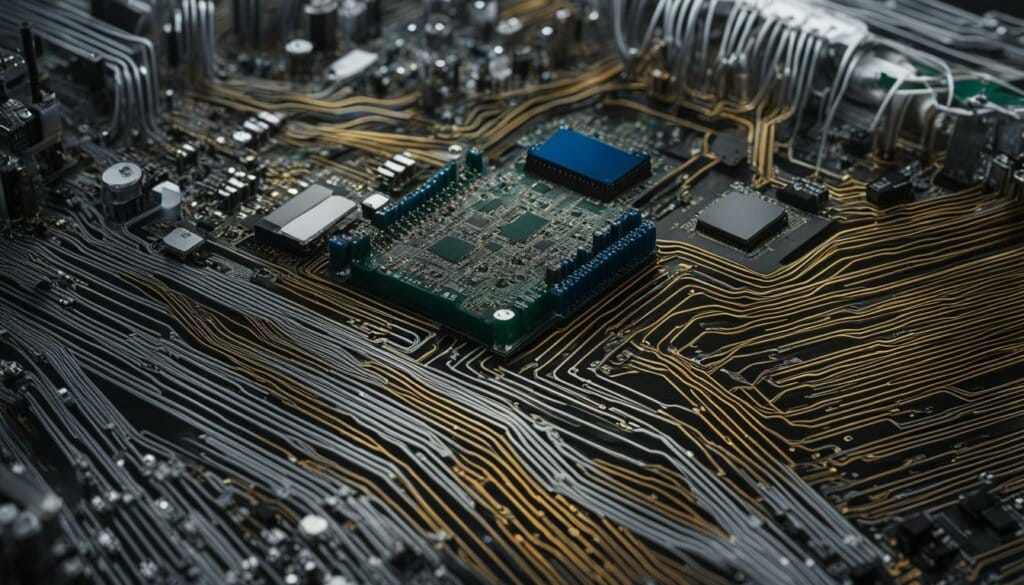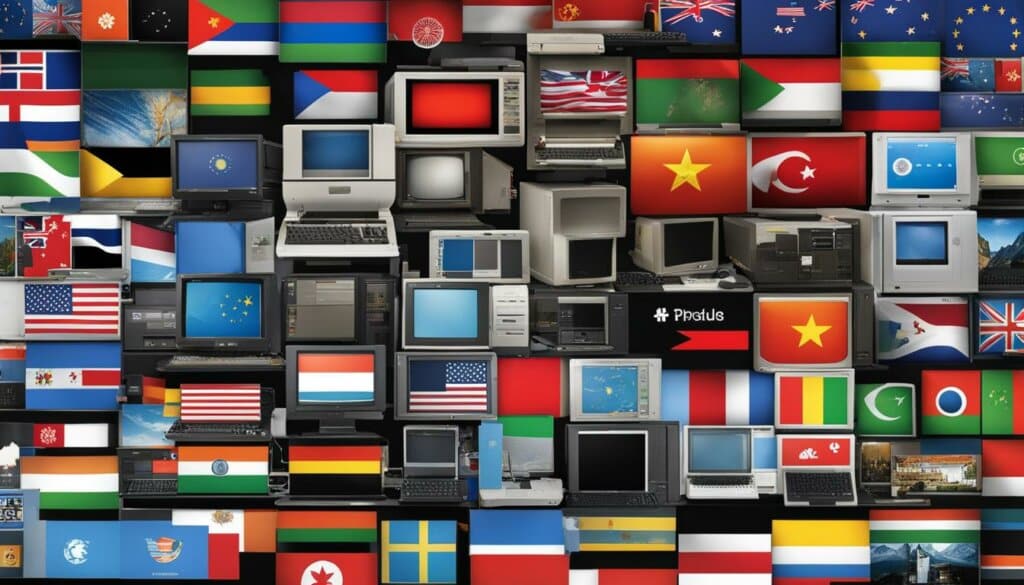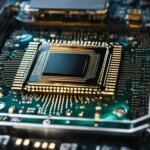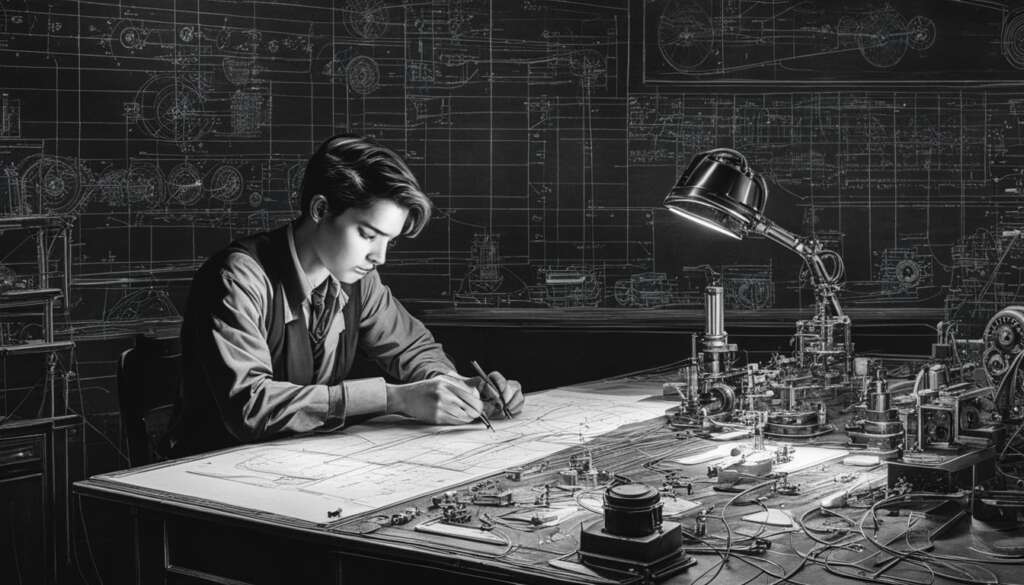Table of Contents
Computers have undergone a remarkable transformation throughout their history, evolving from simple machines to complex systems that shape our future. From the early analog computers to the advanced digital systems of today, computer technology has revolutionized various aspects of society, including science, engineering, programming, and security.
Computer science has paved the way for groundbreaking innovations, enabling us to explore the realms of artificial intelligence, develop sophisticated software, and design efficient hardware components. The field of computer engineering has brought forth advancements in computer hardware, networking, and security, ensuring that our systems are robust and capable of handling the demands of the digital age.
Computer programming plays a pivotal role in harnessing the power of computers, enabling us to create intricate algorithms and applications that streamline processes and improve efficiency. The development of computer software has opened up new possibilities, allowing us to tackle complex problems and realize innovative solutions.
As computers continue to advance, they have become indispensable tools in various industries and sectors. They have revolutionized how we communicate, work, and access information. From personal computers to interconnected networks, computers have become integral to our daily lives.
Key Takeaways:
- Computers have evolved from simple machines to complex systems, shaping our future.
- Computer technology encompasses various disciplines, including computer science, engineering, and programming.
- Computer software enables us to tackle complex problems and drive innovation.
- Computer security is crucial in protecting our systems and data.
- Computers have transformed the way we work, communicate, and access information.
The Precursors of Modern Computers
The journey of computers from simple contraptions to complex systems has been shaped by various precursors. These precursors include analog computers, which used the continuous variation aspect of physical phenomena to solve problems. Analog computers were widely used in scientific and industrial applications, coexisting with digital computers for a while.
Examples of analog computers range from mechanical watches and aircraft flight simulators to synthetic-aperture radar. These machines were particularly valuable in fields such as aircraft flight simulation, where complex calculations were required. However, as digital computers became more advanced and efficient, analog computers gradually became obsolete, paving the way for the rise of their digital counterparts.
Analog computers played a vital role in the early stages of computer development, setting the foundation for the sophisticated systems we have today. Their ability to harness physical phenomena for problem-solving demonstrates the ingenuity of early computer pioneers and their invaluable contributions to the field.
Table: Comparing Analog and Digital Computers
| Feature | Analog Computers | Digital Computers |
|---|---|---|
| Operating Principle | Utilizes continuous variation in physical phenomena | Processes discrete binary data |
| Precision | Can handle continuous values with high precision | Provides exact numerical values through discrete representation |
| Speed | Typically faster than digital computers for certain calculations | Speed depends on processing power and complexity of algorithms |
| Application | Well-suited for scientific and engineering calculations | Used in a wide range of applications, including scientific, commercial, and personal computing |
While analog computers may have become less prevalent in today’s digital era, their impact on computer science and engineering should not be overlooked. They pushed the boundaries of what was possible and provided valuable insights into the world of computation, paving the way for the incredible advancements we witness today.
The Early Computation Devices
The early days of computation witnessed the emergence of fascinating devices that laid the foundation for the development of advanced computers. These devices, such as the Antikythera mechanism, astrolabe, planisphere, and slide rule, symbolized the early advancements in computation and set the stage for future innovations.
The Antikythera mechanism, a remarkable ancient analog computer, was used to determine the positions of heavenly bodies. This intricate device, discovered in a shipwreck near the Greek island of Antikythera, showcased the remarkable knowledge and skill of ancient civilizations in understanding astronomical phenomena.
Another significant early computation device was the astrolabe. This instrument, widely used in spherical astronomy, enabled astronomers to solve various complex problems related to celestial navigation, timekeeping, and astronomical calculations. With its sophisticated design and precise measurements, the astrolabe played a vital role in advancing astronomical knowledge.
In addition to the Antikythera mechanism and the astrolabe, the planisphere and slide rule were also significant tools in early computation. The planisphere, a circular star chart, allowed astronomers to identify and locate stars and constellations at specific times and locations. On the other hand, the slide rule, a mechanical device with sliding scales, facilitated mathematical calculations, including multiplication, division, and logarithmic functions.
| Early Computation Devices | Description |
|---|---|
| Antikythera Mechanism | An ancient analog computer used to determine the positions of heavenly bodies. |
| Astrolabe | An instrument used in spherical astronomy for various calculations related to celestial navigation and timekeeping. |
| Planisphere | A circular star chart that helps astronomers identify and locate stars and constellations. |
| Slide Rule | A mechanical device with sliding scales used for mathematical calculations, including multiplication and division. |

“The early computation devices paved the way for the development of more advanced and sophisticated computers. These devices not only demonstrated the capabilities of early civilizations but also served as the stepping stones for the future evolution of computing.”
The Development of Mechanical Calculators
As computer technology advanced, so did the need for more efficient methods of calculation. The development of mechanical calculators played a crucial role in meeting this demand. These innovative machines simplified complex mathematical calculations, revolutionizing the field of computation.
One of the key advancements in mechanical calculators was John Napier’s invention of Napier’s bones, a system of rods used for multiplication and division. The slide rule, another important tool, enabled engineers and scientists to perform logarithmic and other mathematical calculations quickly and accurately.
“The slide rule is an incredibly powerful tool for engineers and scientists, allowing us to perform complex calculations in a matter of seconds, saving us valuable time and enhancing our productivity.” – Dr. Emily Johnson, Senior Scientist
Building upon these early innovations, mechanical calculators such as Pascaline and Leibniz’s stepped reckoner were developed. These machines utilized gears, levers, and counting mechanisms to perform calculations with remarkable speed and precision. They paved the way for the creation of more advanced and automated computers.
| Mechanical Calculator | Year of Invention | Main Functionality |
|---|---|---|
| Napier’s bones | 1617 | Multiplication and division |
| Slide rule | 1620 | Logarithmic and mathematical calculations |
| Pascaline | 1642 | Addition and subtraction |
| Leibniz’s stepped reckoner | 1673 | Multiplication and division |
These mechanical calculators marked a significant milestone in the history of computation, setting the stage for the development of more sophisticated and efficient computing machines in the years to come.
The Punched-Card Data Processing Era
The punched-card data processing era marked a significant milestone in the evolution of computers. It revolutionized the way data was stored, processed, and manipulated. One of the key figures in this era was Joseph Marie Jacquard, who introduced the concept of punched cards in his revolutionary loom. The Jacquard loom used punched cards to control the weaving patterns, allowing for intricate and complex designs.
Building upon Jacquard’s innovation, Herman Hollerith developed the tabulator and keypunch machine, which played a crucial role in efficient data processing. The tabulator read data from punched cards and performed calculations, while the keypunch machine allowed operators to enter data onto the cards. This electromechanical system greatly improved data storage and processing, enabling faster and more accurate computations.
“The introduction of punched cards in data processing was a game-changer. It allowed for the automation of tasks that were previously done manually, leading to increased efficiency and productivity.” – Computer History Expert
Punched cards became widely used in various applications, including the 1890 United States Census, where Hollerith’s machines were employed to process vast amounts of data. This era also saw the development of electromechanical relays, which provided the necessary switching capabilities for punched-card systems. These relays acted as the electronic switches that allowed the machines to read, interpret, and manipulate the data stored on the punched cards.
| Key Figures | Innovations | Impact |
|---|---|---|
| Joseph Marie Jacquard | Punched cards in loom | Revolutionized textile industry |
| Herman Hollerith | Tabulator, keypunch machine | Efficient data processing |
| Electromechanical relays | Switching capabilities for punched-card systems | Enabled automation and faster computations |
The punched-card data processing era laid the foundation for further advancements in computer technology. It showcased the power and potential of automated data handling, paving the way for future developments and innovations in the field.
The Rise of Digital Computers
The advent of digital computers marked a significant milestone in the history of computing. With the development of integrated circuit technology and transistor technology, computers became more powerful, compact, and accessible. The introduction of these technological innovations revolutionized the computing landscape, paving the way for the miniaturization of personal computers and the widespread use of digital computing in various domains.
Integrated circuits, also known as microchips, played a crucial role in the advancement of digital computers. These small electronic devices incorporated multiple transistors and other circuit elements onto a single semiconductor chip, significantly improving the computing power and efficiency of computers. The invention of the integrated circuit chip by Jack Kilby and Robert Noyce in the late 1950s laid the foundation for the creation of smaller, faster, and more reliable computers.
Transistor technology further propelled the development of digital computers. Transistors, which replaced bulky and power-consuming vacuum tubes, offered enhanced performance, reliability, and miniaturization. The invention of the transistor by John Bardeen, Walter Houser Brattain, and William Shockley in 1947 revolutionized the electronics industry and paved the way for the creation of more sophisticated and efficient computers.

The Evolution of Software
Software has played a crucial role in the evolution of computers, constantly pushing the boundaries of what is possible. From the early days of computer programming to the modern era of sophisticated software systems, the development of software has shaped the capabilities and functionalities of computers.
One significant milestone in software evolution was the emergence of software configuration management. This concept revolutionized the management of software development processes, enabling better collaboration, version control, and efficient deployment of software systems.
“Software configuration management is like organizing an orchestra – it ensures that every piece of software works harmoniously together to create a beautiful symphony of functionality.” – Software Engineer
One pivotal development in operating systems was the creation of Unix in the 1970s. Unix provided a powerful and flexible operating system that became widely adopted in academia and the industry. It laid the foundation for subsequent innovations in operating systems and influenced the design of modern computer systems.
The open-source movement also played a significant role in software evolution. The rise of free software and open-source software has fostered collaboration and innovation, enabling developers from around the world to contribute and improve upon existing software. It has led to the creation of powerful and robust software solutions that are freely available to everyone.
The Evolution of Software
Software configuration management, Unix, and open-source software have revolutionized the way we develop, manage, and distribute software. They have paved the way for a new era of software engineering, where collaboration and innovation thrive. As computers continue to advance, software will remain at the forefront, driving further advancements and shaping the future of computing.
| Software Milestone | Description |
|---|---|
| Software Configuration Management | A concept that revolutionized the management of software development processes, enabling better collaboration, version control, and efficient deployment of software systems. |
| Unix | A powerful and flexible operating system that laid the foundation for subsequent innovations in operating systems and influenced the design of modern computer systems. |
| Open-Source Software | The rise of free software and open-source software has fostered collaboration and innovation, enabling developers from around the world to contribute and improve upon existing software. |
The Field of Computer Science
The field of computer science encompasses a wide range of disciplines and areas of study. One of the key focuses in computer science is artificial intelligence (AI), which aims to develop machines that can perform tasks typically requiring human intelligence. AI has made significant advancements in recent years, with applications ranging from voice assistants like Siri and Alexa to self-driving cars. It is an exciting field that continues to push the boundaries of what machines can achieve.
Another important area of study in computer science is compiler construction. Compilers are crucial tools that translate high-level programming languages into executable code. They optimize the performance of software and enable developers to write programs in languages like C++, Java, and Python. Without compilers, programming would be much more challenging and time-consuming.
Operating systems are another vital component of computer science. An operating system manages computer hardware and software resources, providing a platform for other software to run efficiently. Popular operating systems include Windows, macOS, and Linux. They handle tasks such as memory management, process scheduling, and device driver management, ensuring the smooth functioning of computers.
Programming languages are the building blocks of computer science. They provide a way for humans to communicate with computers, enabling the development of software and applications. Programming languages like C, Java, and Python have their strengths and weaknesses, and choosing the right language for a project is crucial. Each language has its unique syntax and features, allowing developers to solve different types of problems efficiently.
In summary, computer science is a dynamic and diverse field that encompasses various disciplines. Its advancements in artificial intelligence, compiler construction, operating systems, and programming languages have shaped the capabilities and possibilities of modern computers. As technology continues to evolve, computer science will continue to play a vital role in driving innovation and shaping our future.
The Impact of Computers on Society
The development of computer technology has had a transformative impact on society, revolutionizing various aspects of our lives. From the introduction of general-purpose CPUs to the creation of the internet, computers have become essential tools in our daily routines. Let’s explore some key areas where computers have made a significant impact.
Laptops and Personal Computers
Laptops and personal computers have become indispensable devices for work, education, and entertainment. They provide us with access to a wealth of information and enable us to communicate and collaborate with others around the world. Whether it’s writing documents, creating spreadsheets, or editing photos and videos, computers have streamlined our tasks and increased productivity.
Video Games and Entertainment
Computers have revolutionized the world of entertainment through the development of video games. Gaming has become a multi-billion-dollar industry, offering immersive experiences and bringing people together through online multiplayer features. Additionally, computers have enabled the streaming and consumption of various forms of media, including movies, music, and TV shows, providing endless entertainment options at our fingertips.
The World Wide Web and the Internet
The advent of the internet and the World Wide Web has transformed how we access information, communicate, and connect with others. The internet has opened up a vast digital landscape, allowing us to browse websites, search for information, and connect with people from all corners of the globe. It has revolutionized industries such as commerce, education, and journalism, creating new opportunities and challenges for individuals and businesses alike.
| Keyword | Description |
|---|---|
| General-Purpose CPUs | Central processing units that can handle a wide range of tasks and applications |
| Graphical User Interface | Visual interface that allows users to interact with computers using icons and menus |
| Internet | A global network that connects computers and facilitates communication and information sharing |
| Laptops | Portable computers that allow users to work and access information on the go |
| Personal Computers | Computers designed for individual use, typically found in homes and offices |
| Video Games | Interactive electronic games played on computers or gaming consoles |
| World Wide Web | A system of interlinked hypertext documents accessible via the internet |
| Cloud | A network of remote servers used for storing and accessing data over the internet |
These are just a few examples of how computers have shaped our society. From the exponential increase in computational power to the widespread adoption of cloud technologies, computers continue to shape the world we live in. As technology advances, we can expect further innovations that will further transform our lives and drive us towards a more connected and digital future.

Computers in Different Countries
Computers have played a significant role in shaping the technological landscape of various countries. From scientific research to military applications, computers have been instrumental in driving progress and innovation. Let’s explore the contributions and advancements made by different countries in the field of computer technology.
Bulgaria
In Bulgaria, computers have been utilized extensively in scientific research and technological development. The country has made significant contributions to computer hardware and software, with a focus on areas such as computational mathematics, artificial intelligence, and information technology. Bulgarian researchers and engineers have played an active role in advancing computer science and have made remarkable contributions to the field.
Eastern Bloc
The Eastern Bloc countries, including Poland, Romania, and the Soviet Union, have made notable strides in computer technology. These countries have invested heavily in computer research and development, particularly in the areas of mainframe computers, computer architecture, and software engineering. Their efforts have led to the creation of powerful computing systems and groundbreaking advancements in computer science.
Yugoslavia
Yugoslavia also had a strong presence in the field of computer technology. The country had a vibrant computing industry and made substantial contributions to computer hardware manufacturing and software development. Yugoslavian engineers and scientists played a crucial role in advancing computer science, contributing to the global technological landscape.
| Country | Contributions |
|---|---|
| Bulgaria | Advancements in computational mathematics, artificial intelligence, and information technology |
| Eastern Bloc | Development of mainframe computers, computer architecture, and software engineering |
| Yugoslavia | Strong presence in computer hardware manufacturing and software development |
These countries have each made significant contributions to the field of computer technology, shaping the trajectory of computer science and industry. Their advancements and innovations have paved the way for the development of more sophisticated and powerful computers, pushing the boundaries of what is possible in the world of technology.

Conclusion
Computers have come a long way in their journey from simple machines to complex systems. They have revolutionised numerous aspects of society and have become integral to modern life.
Computer technology, computer science, computer engineering, and computer programming continue to evolve, pushing the boundaries of what is possible and shaping the future of innovation.
From analog computers to digital systems, from mechanical calculators to advanced software, computers have transformed the way we work, communicate, and interact with the world. The field of computer science continues to drive progress, enabling new discoveries and advancements in technology.
As we look to the future, the impact of computers and their continued development will be even more profound. With computers at the forefront of innovation, the possibilities are endless, and the potential to change the world is immense.
FAQ
What were analog computers used for?
Analog computers were widely used in scientific and industrial applications, especially in fields like aircraft flight simulation and synthetic-aperture radar.
When did analog computers start becoming obsolete?
Analog computers started becoming obsolete in the 1950s and 1960s, as digital computers became more advanced and efficient.
What were the precursors of modern computers?
The precursors of modern computers include analog computers, which used the continuous variation aspect of physical phenomena to solve problems.
What were early computation devices used for?
Early computation devices, such as the Antikythera mechanism, astrolabe, planisphere, and slide rule, were used for calculation and measurement in fields like astronomy.
How did mechanical calculators contribute to computation?
Mechanical calculators like Napier’s bones, slide rules, Pascaline, and Leibniz’s stepped reckoner simplified calculations and improved efficiency.
How did punched-card data processing revolutionize computation?
Punched-card data processing, pioneered by Joseph Marie Jacquard and Herman Hollerith, enabled efficient data storage and processing in various applications.
What was the impact of digital computers?
The advent of digital computers marked a significant shift in computing technology, leading to more powerful and compact machines that became widely used in various domains.
How did software contribute to the evolution of computers?
Software played a crucial role in the evolution of computers, with advancements like software configuration management, operating systems, and programming languages driving progress.
What is the field of computer science focused on?
The field of computer science encompasses various disciplines and fields of study, including artificial intelligence, compiler construction, and operating systems.
What impact have computers had on society?
Computers have had a profound impact on society, revolutionizing aspects like computational power, user interactions, communication, work, entertainment, and data storage.
How have computers been used in different countries?
Computers have been used for different purposes in various countries, including scientific research, military applications, and social development, shaping their trajectories in computer science and industry.













